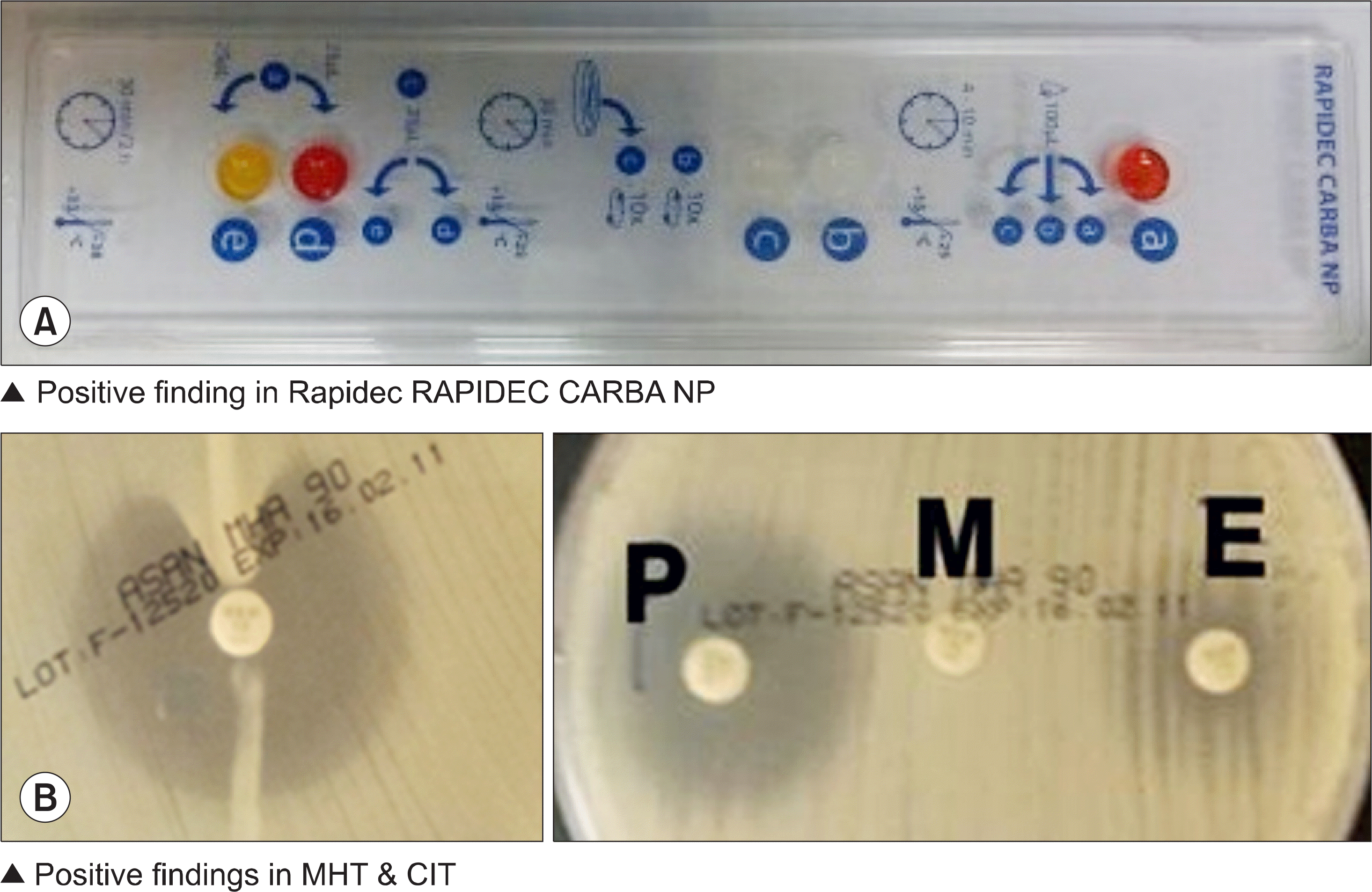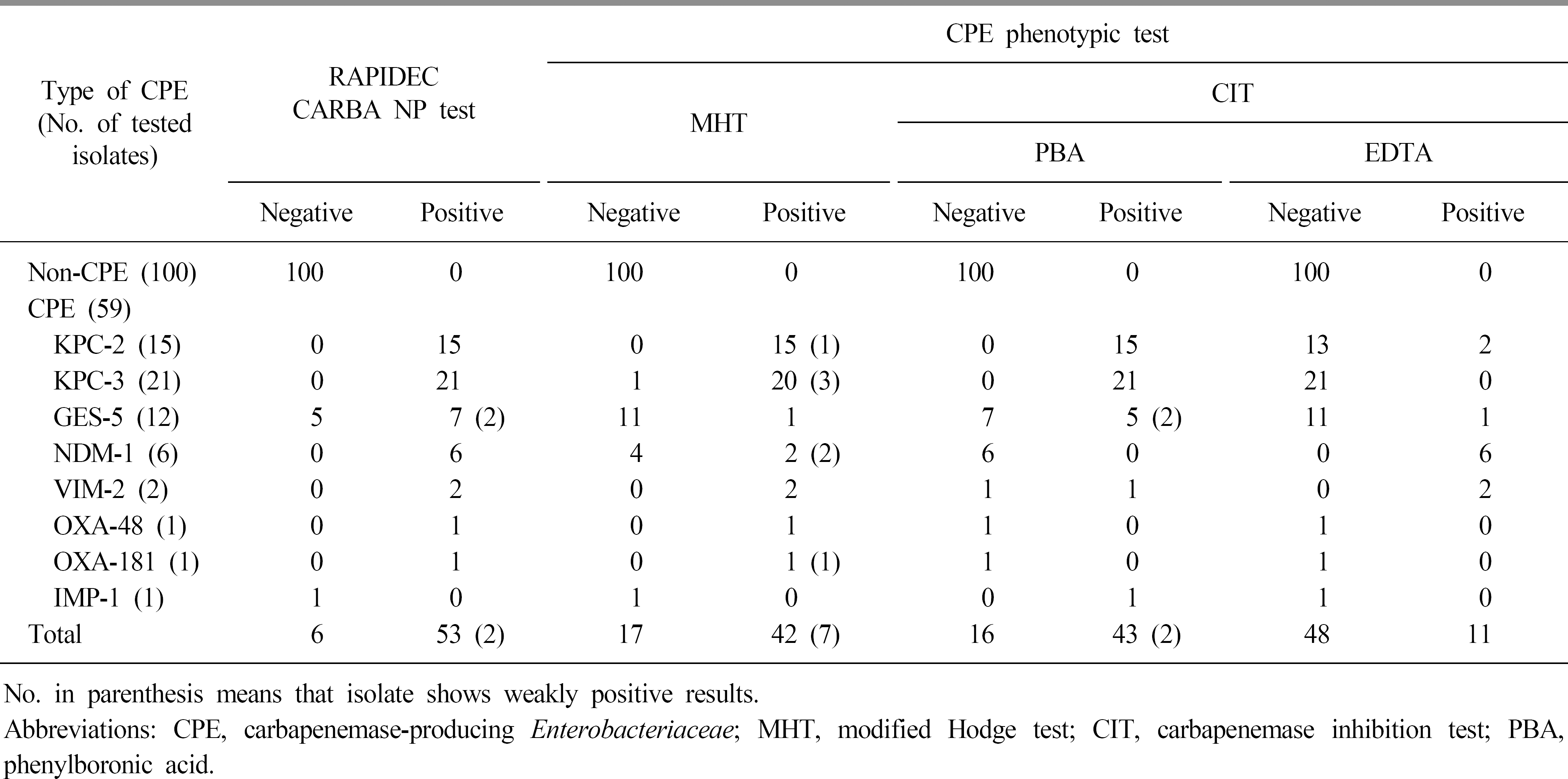Abstract
Background
Extended-spectrum β-lactamase (ESBL)-producing Enterobacteriaceae are resistant to most β-lactam antibiotics except carbapenems. In recent years, infrequently isolated Enterobacteriaceae that produce carbapenemase pose a serious threat in the selection of appropriate therapeutic antibiotics. The rapid detection method of carbapenemase-producing Enterobacteriaceae (CPE) is necessary to prevent the spread of CPE into healthcare facilities.
Methods
One hundred clinical Enterobacteriaceae isolates (Klebsiella pneumoniae 40, Escherichia coli 40, others 20) showing susceptibility to carbapenems and positivity in the CLSI ESBL phenotypic test from November 2015 to March 2016 and 59 stocked Enterobacteriaceae isolates harboring resistance genes producing carbapenemase (K. pneumoniae 56, Enterobacter cloacae 2, E. coli 1; types of CPE: KPC 36, GES 12, NDM 6, VIM 2, OXA 2, IMP 1) were sub-jected to the RAPIDEC CARBA NP test (bioMérieux, France) and CPE phenotypic test using the modified Hodge test (MHT) and carbapenemase inhibition test.
Results
All of the 100 Enterobacteriaceae isolates with carbapenem susceptibility and ESBL positivity were negative on the RAPIDEC CARBA NP test and CPE phenotypic test. Of 59 stock CPE isolates, 53 and 42 showed positive results to the RAPIDEC CARBA NP test and MHT, respectively. The sensitivity and specificity of the RAPIDEC CARBA NP test for detecting CPE were 89.8% and 100%, respectively.
Go to : 
References
1. Hidron AI, Edwards JR, Patel J, Horan TC, Sievert DM, Pollock DA, et al. NHSN annual update: antimicrobial-resistant pathogens associated with healthcare-associated infections: annual summary of data reported to the National Healthcare Safety Network at the Centers for Disease Control and Prevention, 2006–2007. Infect Control Hosp Epidemiol. 2008; 29:996–1011.
3. Gupta N, Limbago BM, Patel JB, Kallen AJ. Carbapenem-resistant Enterobacteriaceae: epidemiology and prevention. Clin Infect Dis. 2011; 53:60–7.

4. Garg A, Garg J, Upadhyay GC, Agarwal A, Bhattacharjee A. Evaluation of the rapidec carba NP test kit for detection of carbapenemase-producing gram-negative bacteria. Antimicrob Agents Chemother. 2015; 59:7870–2.

5. Poirel L and Nordmann P. Rapidec Carba NP test for rapid detection of carbapenemase producers. J Clin Microbiol. 2015; 53:3003–8.
6. Nordmann P, Poirel L, Dortet L. Rapid detection of carbapenemase-producing Enterobacteriaceae. Emerg Infect Dis. 2012; 18:1503–7.
7. CLSI. Performance standards for antimicrobial susceptibility testing. CLSI document M100S. Wayne, PA: Clinical and Laboratory Standards Institute;2016.
8. Jeong S, Kim JO, Jeong SH, Bae IK, Song W. Evaluation of peptide nucleic acid-mediated multiplex realtime PCR kits for rapid detection of carbapenemase genes in gram-negative clinical isolates. J Microbiol Methods. 2015; 113:4–9.

9. Song W, Hong SG, Yong D, Jeong SH, Kim HS, Kim HS, et al. Combined use of the modified Hodge test and carbapenemase inhibition test for detection of carbapenemase-producing Enterobacteriaceae and metallo-β-lactamase-producing Pseudomonas spp. Ann Lab Med. 2015; 35:212–9.

10. Thomson KS. Extended-spectrum-β-lactamase, AmpC, and carbapenemase issues. J Clin Microbiol. 2010; 48:1019–25.

11. Girlich D, Poirel L, Nordmann P. Value of the modified Hodge test for detection of emerging carbapenemases in Enterobacteriaceae. J Clin Microbiol. 2012; 50:477–9.

12. Dortet L, Agathine A, Naas T, Cuzon G, Poirel L, Nordmann P. Evaluation of the RAPIDECⓇ CARBA NP, the Rapid CARB ScreenⓇ and the Carba NP test for biochemical detection of carbapenemase-producing Enterobacteriaceae. J Antimicrob Chemother. 2015; 70:3014–22.
13. Kabir MH, Meunier D, Hopkins KL, Giske CG, Woodford N. A two-centre evaluation of RAPIDECⓇ CARBA NP for carbapenemase detection in Enterobacteriaceae, Pseudomonas aeruginosa and Acinetobacter spp. J Antimicrob Chemother. 2016; 71:1213–6.
14. Studentova V, Papagiannitsis CC, Izdebski R, Pfeifer Y, Chudackova E, Bergerova T, et al. Detection of OXA-48-type carbapenemase-producing Enterobacteriaceae in diagnostic laboratories can be enhanced by addition of bicarbonates to cultivation media or reaction buffers. Folia Microbiol (Praha). 2015; 60:119–29.

15. Park JW, Lee EJ, Lee DH. Status of carbapenemase-producing Enterobacteriaceae in Korea, 2014. Public Health Weekly Report. 2016; 9:9–13.
Go to : 
 | Fig. 1.Phenotype results of KPC-producing K. pneumoniae. (A) Positive finding in RAPIDEC CARBA NP,(B) Positive finding in MHT and CIT. Abbreviations: P, phenylboronic acid disk; M, meropenem disk; E, EDTA disk. |
Table 1.
Results of RAPIDEC CARBA NP test result according to reading time




 PDF
PDF ePub
ePub Citation
Citation Print
Print



 XML Download
XML Download